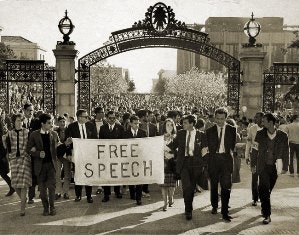
On Dec. 2, following weeks of demonstrations and failed negotiations, more than 1,000 students took over the administration building in what would be the apex of the Free Speech Movement.
The sit-in ended the next day with 814 people arrested, the largest mass arrests in California history. Support from sympathetic faculty and others eventually opened the university to student activism in early 1965.
College campuses across the country would never be the same.
What sparked the sparked the free speech movement?
Political activities involving off-campus causes were prohibited at University of California campuses in 1964. At Berkeley, students and outside activists instead set up tables, handed out leaflets and did fundraising on a 26-foot-wide brick walkway at the campus’ Telegraph Avenue entrance.
That September, after Berkeley students took part in civil rights protests against Bay Area businesses and at the Republican National Convention in San Francisco, the dean of students notified student organizations that the walkway was university property and could not be used “to support or advocate off-campus political or social action.”
Students defiantly set up tables on the walkway and within the campus. The civil disobedience came to a head on Oct. 1, when police tried to arrest a former student staffing a table for the Congress on Racial Equality. Hundreds of students surrounded the police car to keep it from carrying him away.
The standoff ended after 32 hours when UC President Clark Kerr agreed not to press charges and to appoint a committee of students, faculty and administrators to craft recommendations on student speech issues. But the two sides were unable to reach an agreement, setting the stage for further protests and ultimately the show-down in December.
Who were the main players?
No individual is more closely identified with the FSM than Mario Savio. The 21-year-old philosophy major, who just returned from registering black voters in Mississippi, rallied fellow students with soaring rhetoric that captured the moment and foreshadowed the youth-led uprisings of the later-1960s and early-1970s.
“There’s a time when the operation of the machine becomes so odious, makes you so sick at heart that you can’t take part!” Savio said in a memorable speech delivered just before the Dec. 2 sit-in. “And you’ve got to put your bodies upon the gears and upon the wheels, upon the levers, upon all the apparatus, and you’ve got to make it stop!”
Folk singer Joan Baez, then 23, led the crowd that marched into the administration building in singing “We Shall Overcome.” Some leaders went on to notable careers, including artist David Lance Goines and Jackie Goldberg, one of the first lesbians to serve in the California Legislature. Savio suffered a fatal heart attack while teaching at Sonoma State University in 1996.
Backlash affected the fortunes of officials who tried in vain to quell the student unrest. In 1966, Ronald Reagan, who had campaigned in part on a promise to “clean up the mess at Berkeley,” unseated two-term California Gov. Edmund G. “Pat” Brown, who ordered the Dec. 3 arrests. Three weeks after Reagan became governor, Kerr, the UC president, was fired.
Did the FSM have anything to do with Vietnam?
Indirectly. Large student protests against the Vietnam War were held in San Francisco, New York and other cities in spring 1964, but it was not until President Lyndon Johnson expanded the war in the months after the FSM that the conflict became a focus of campus political activity.
Students held anti-war teach-ins at Berkeley, burned draft cards at the local draft board and marched to the Army Induction Center in Oakland.
By 1968, with the war and the counter-culture well-established, students with demands for social change were clashing with police and universities worldwide.
“I think about the Free Speech Movement as helping to end the McCarthy era and paving the way for the anti-war protests that came later,” said New York University historian Robert Cohen, the author of several books about Savio and a visiting professor at Berkeley this term.
Are Berkeley students politically active today?
Attending a school with a Free Speech Movement Cafe and an annual Mario Savio Memorial Lecture, Cal students are well aware of their legacy. The plaza where the police car was surrounded has seen many protests, from sleep-ins aimed at persuading the university to divest its money from South Africa in 1985 to an Occupy Wall Street-style encampment in 2011 that campus police broke up with batons.
In a cause that hits closer to home, hundreds of students occupied a campus classroom building for a week this month to protest a series of tuition hikes.
How is Berkeley commemorating the 50th anniversary?
Reverently, yet orderly. Students are planning to gather at Sproul Hall on Tuesday to read from letters students who were arrested 50 years ago wrote to the judge explaining why they took part in the protest.
FSM veterans returned to campus this fall for a reunion with panel discussions, a musical about the 1964 protests co-written by one of Savio’s sons and an anniversary rally.
Looking over a sea of gray heads, Goldberg mused about how quickly the decades had passed. But to her fellow children of The Sixties, her message was timeless.
“Every morning, get up and look in the mirror as you are brushing those dentures and say to yourself, ‘I will not be cynical today. I will not believe the crap that everyone is in it for themselves. I will not believe that everyone is corrupt. I will not believe the propaganda that tells me it is all hopeless,” she said. “It is never hopeless.’”















